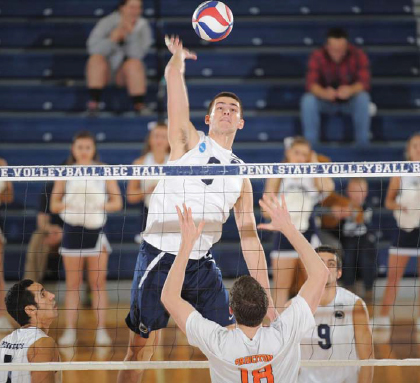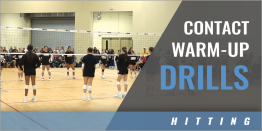|
By: Jay Hosack - Head Coach at George Mason University (Formerly Asst. Coach at Penn State) Originally published in: Coaching Volleyball Magazine Provided by: American Volleyball Coaches Association (AVCA)
How many times have you heard one of your hitters tell your setter to "set me higher," or you see them raise their thumbs when looking at them after the play? Out of all of the communication between your setters and hitters, this is probably the most common occurrence. When players start at a young age, they are taught to watch the set and go attack it. Most coaches that teach volleyball to youngsters are not concerned with timing and tempo of the hitter/setter connection. So, when they reach college, some of them are constantly telling their setter to "get me higher." As the offensive coordinator at Penn State, one of my main areas of focus is to watch our offense, and to determine what each hitter and our setters are doing in order to connect. I watch video endlessly with our hitters, and spend many hours with our setters watching their shape and speed of each set to each player. One of the main topics that I discuss with our setters is that from day one in our gym, they must start what I call a "mental rolodex" for each hitter. Some hitters are tremendous athletes, and contact the ball at a very high point, therefore needing a higher set, while others are more successful with a quicker and lower set. Each hitter's "window" is different, and it can change over time. The most successful setters adjust to each of their needs. The setters and I sit down and watch many hours of video over the course of their careers. Good setters see the difference, and make those adjustments. Secondly, I sit down with each of our hitters, and we discuss the "tempo" of each set we run. When I say tempo, I am referring not to the speed of the set, but rather to what step the hitter is on in their approach when the setter has the ball in their hands (we use 4 steps for our pin hitters). Most coaches talk about tempo in reverse to what we usually describe it as. To them, a 1st tempo set would be a Quick, or Fl. We would call a 1st tempo set a Hut, or an out-of-system high ball (being that the hitter would be on their first step when the setter sets the ball). Many times, especially with newer players, they will constantly tell our setters to get them higher. When I sit down with them, and ask them what set they were calling for, this would be a typical response: "We are running a Go ball, coach." To which I reply, "What step should you be on when the setter has the ball in his hands?" A Go ball for us is a faster set to the pin, and is a 2nd step minimum, on the way towards the 3rd. When I ask the player if he is in tempo, and he says yes, we look at the video. More times than not, they are either not going at all, or are on the first step of their approach. The end result being that the hitter is late and the ball is already past them, thereby making them turn and tell the setter to get them higher after the play. Now, after watching video, the hitter can see that they were late, and can make the adjustment next time they are on the court by speeding up their foot-work to match the setter. Problem solved! For our middle blockers on their quick Fl attacks, we would call that a 4th step tempo set. We like them to be in the air already when the ball gets released out of the setter's hands. Many times our younger middles are either on their 3rd step or still on the ground when they should already be in the air. If they are late, even if only by a little, they are jumping for a ball that is already out of reach and it's going up and away from them at the same time. It's not a good scenario, and we have all seen the "paintbrush" attack over our years. We want the ball to be attacked when it's either on the way up, or at its peak. This process takes time for the hitters and setters to get used to. However, unlike some other skills we train (passing and blocking are two examples) the progress can be quite quick with the right vision and learning. Having your players watch video is a key component to their learning process.
|








